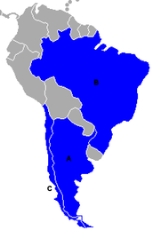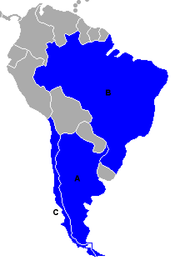
ABC countries
Encyclopedia

South America
South America is a continent situated in the Western Hemisphere, mostly in the Southern Hemisphere, with a relatively small portion in the Northern Hemisphere. The continent is also considered a subcontinent of the Americas. It is bordered on the west by the Pacific Ocean and on the north and east...
n countries of Argentina
Argentina
Argentina , officially the Argentine Republic , is the second largest country in South America by land area, after Brazil. It is constituted as a federation of 23 provinces and an autonomous city, Buenos Aires...
, Brazil
Brazil
Brazil , officially the Federative Republic of Brazil , is the largest country in South America. It is the world's fifth largest country, both by geographical area and by population with over 192 million people...
and Chile
Chile
Chile ,officially the Republic of Chile , is a country in South America occupying a long, narrow coastal strip between the Andes mountains to the east and the Pacific Ocean to the west. It borders Peru to the north, Bolivia to the northeast, Argentina to the east, and the Drake Passage in the far...
, which are seen as three of the most powerful and wealthy countries in South America. The term was mostly used in the first half of the 20th century when they worked together to develop common interests and a coordinated approach to issues in the region with relatively little influence from outside powers in contrast with the Cold War
Cold War
The Cold War was the continuing state from roughly 1946 to 1991 of political conflict, military tension, proxy wars, and economic competition between the Communist World—primarily the Soviet Union and its satellite states and allies—and the powers of the Western world, primarily the United States...
governments.
ABC Powers Conference, 1914
This is the first well-known use of the phrase 'ABC Powers'. On May 20, 1914, the ABC Powers met in Niagara FallsNiagara Falls, Ontario
Niagara Falls is a Canadian city on the Niagara River in the Golden Horseshoe region of Southern Ontario. The municipality was incorporated on June 12, 1903...
, Canada
Canada
Canada is a North American country consisting of ten provinces and three territories. Located in the northern part of the continent, it extends from the Atlantic Ocean in the east to the Pacific Ocean in the west, and northward into the Arctic Ocean...
, to mediate diplomatically in order to avoid war
War
War is a state of organized, armed, and often prolonged conflict carried on between states, nations, or other parties typified by extreme aggression, social disruption, and usually high mortality. War should be understood as an actual, intentional and widespread armed conflict between political...
between the United States
United States
The United States of America is a federal constitutional republic comprising fifty states and a federal district...
and Mexico
Mexico
The United Mexican States , commonly known as Mexico , is a federal constitutional republic in North America. It is bordered on the north by the United States; on the south and west by the Pacific Ocean; on the southeast by Guatemala, Belize, and the Caribbean Sea; and on the east by the Gulf of...
after increasing tensions over the Tampico Affair
Tampico Affair
The Tampico Affair started off as a minor incident involving U.S. sailors and Mexican land forces loyal to General Victoriano Huerta during the guerra de las facciones phase of the Mexican Revolution...
and the United States occupation of Veracruz, and developing issues that led to the Mexican Revolution
Mexican Revolution
The Mexican Revolution was a major armed struggle that started in 1910, with an uprising led by Francisco I. Madero against longtime autocrat Porfirio Díaz. The Revolution was characterized by several socialist, liberal, anarchist, populist, and agrarianist movements. Over time the Revolution...
. At the conference, the United States was represented by Frederick William Lehmann
Frederick William Lehmann
Frederick William Lehmann was a prominent American lawyer, statesman, United States Solicitor General, and rare book collector.-Biography:...
, a former United States Solicitor General
United States Solicitor General
The United States Solicitor General is the person appointed to represent the federal government of the United States before the Supreme Court of the United States. The current Solicitor General, Donald B. Verrilli, Jr. was confirmed by the United States Senate on June 6, 2011 and sworn in on June...
, and Joseph Rucker Lamar
Joseph Rucker Lamar
Joseph Rucker Lamar was an Associate Justice of the United States Supreme Court appointed by President William Howard Taft...
, an Associate Justice
Associate Justice
Associate Justice or Associate Judge is the title for a member of a judicial panel who is not the Chief Justice in some jurisdictions. The title "Associate Justice" is used for members of the United States Supreme Court and some state supreme courts, and for some other courts in Commonwealth...
of the Supreme Court of the United States
Supreme Court of the United States
The Supreme Court of the United States is the highest court in the United States. It has ultimate appellate jurisdiction over all state and federal courts, and original jurisdiction over a small range of cases...
.
ABC Pact, 1915
On May 15, 1915, the ABC Powers met again to sign a more formal treaty, designed to develop cooperationCooperation
Cooperation or co-operation is the process of working or acting together. In its simplest form it involves things working in harmony, side by side, while in its more complicated forms, it can involve something as complex as the inner workings of a human being or even the social patterns of a...
, nonaggression and the arbitration
Arbitration
Arbitration, a form of alternative dispute resolution , is a legal technique for the resolution of disputes outside the courts, where the parties to a dispute refer it to one or more persons , by whose decision they agree to be bound...
of disputes. It was formulated to resist United States' influence in the region
Monroe Doctrine
The Monroe Doctrine is a policy of the United States introduced on December 2, 1823. It stated that further efforts by European nations to colonize land or interfere with states in North or South America would be viewed as acts of aggression requiring U.S. intervention...
and to establish a mechanisms for consultation among the three signatory countries, such as setting up a permanent mediation commission. The official name was the Consultation, Non-Aggression and Arbitration Pact.
Although the treaty was not official until it was ratified by Brazil, much of the foreign policy of the three signatories between 1915 to 1930 followed the basis of consultations and mutual initiative which the ABC Pact envisaged. To this end, the press used the name "ABC Pact" when the signatory countries co-operated to pursue integration initiatives in South America, concluded official agreements or actions regarding foreign policy
Foreign policy
A country's foreign policy, also called the foreign relations policy, consists of self-interest strategies chosen by the state to safeguard its national interests and to achieve its goals within international relations milieu. The approaches are strategically employed to interact with other countries...
, or promoted ideologically and politically similar organizations within the region.
Peru-Ecuador War, 1942
In 1942 the ABC powers and the United StatesUnited States
The United States of America is a federal constitutional republic comprising fifty states and a federal district...
mediated in the peace terms of the Ecuadorian–Peruvian War. This led to the loss of all disputed territory in the Amazon Basin
Amazon Basin
The Amazon Basin is the part of South America drained by the Amazon River and its tributaries that drains an area of about , or roughly 40 percent of South America. The basin is located in the countries of Bolivia, Brazil, Colombia, Ecuador, Guyana, Peru, and Venezuela...
that was administered by Ecuador before the war.
See also
- Andean Community of NationsAndean Community of NationsThe Andean Community is a customs union comprising the South American countries of Bolivia, Colombia, Ecuador and Peru. The trade bloc was called the Andean Pact until 1996 and came into existence with the signing of the Cartagena Agreement in 1969...
- Argentina–Brazil relations
- Argentina–Chile relations
- Brazil–Chile relations
- MercosurMercosurMercosur or Mercosul is an economic and political agreement among Argentina, Brazil, Paraguay and Uruguay. Founded in 1991 by the Treaty of Asunción, which was later amended and updated by the 1994 Treaty of Ouro Preto. Its purpose is to promote free trade and the fluid movement of goods, people,...

